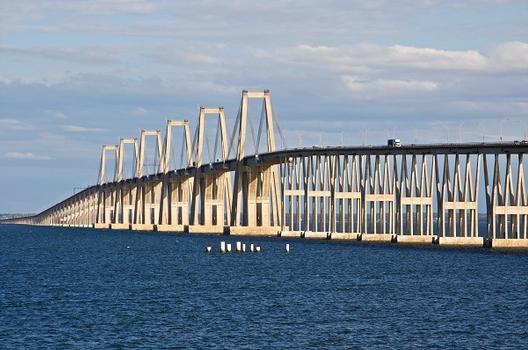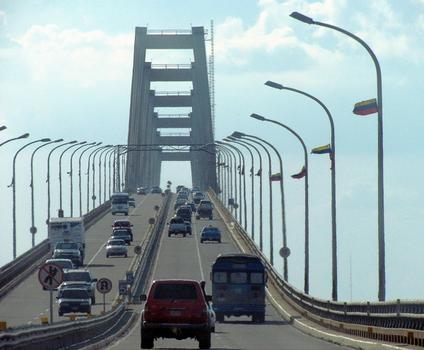General Information
| Name in local language: | Puente General Rafael Urdaneta |
|---|---|
| Other name(s): | Maracaibo Bridge |
| Beginning of works: | 1958 |
| Completion: | 24 August 1962 |
| Status: | in use |
Project Type
| Structure: |
Multiple-span cable-stayed bridge |
|---|---|
| Function / usage: |
Motorway bridge / freeway bridge |
| Material: |
Prestressed concrete bridge |
| Support conditions: |
for registered users |
| Material: |
Structurae Plus/Pro - Subscribe Now! Structurae Plus/Pro - Subscribe Now! |
Location
| Location: |
Maracaibo, Zulia, Venezuela |
|---|---|
| Crosses: |
|
| Coordinates: | 10° 34' 28" N 71° 34' 31" W |
Technical Information
Dimensions
| total length | 8.7 km | |
| number of spans | 135 | |
| approach viaducts | ||
|---|---|---|
| span lengths of approaches | 26 x 85.0 m - 2 x 65.8 m - 79 x 46.6 m - 20 x 36.6 m - 1 x 22.6 m | |
| embankment | ||
| length | 406.0 m | |
| main bridge | ||
| main spans | 5 x 235 m | |
| span lengths of main bridge | 160.00 m - 5 x 235 m - 160.00 m | |
| vertical navigation clearance | 50 m | |
| deck | deck depth | 5.00 m |
| deck width | 17.40 m | |
| pylons | pylon height | 86.60 m |
Materials
| cables |
steel
|
|---|---|
| deck |
reinforced concrete
|
| piers |
reinforced concrete
|
| pylons |
reinforced concrete
|
Chronology
| 1957 | International competition |
|---|---|
| 24 August 1962 | Opening |
| 6 April 1964 | After a ship collides with a pier one of the span collapses into the water. Seven persons are killed in the collapse. |
Excerpt from Wikipedia
The General En Jefe Rafael Urdaneta Bridge is located at the Tablazo Strait outlet of Lake Maracaibo, in western Venezuela. The bridge connects Maracaibo with much of the rest of the country. It is named after General Rafael Urdaneta, a Venezuelan hero of Independence.
Design and construction
Made of reinforced and prestressed concrete, the cable-stayed bridge spans 8,678 metres (5.392 mi) from shore to shore. The five main spans are each 235 metres (771 ft) long. They are supported from 92-metre (302 ft) tall towers, and provide 46 metres (151 ft) of clearance to the water below. The bridge carries only vehicles.
The competition to design the bridge started in 1957 and was won by Riccardo Morandi, an Italian civil engineer. Morandi's was the only concrete design out of twelve entries, and was expected to be less expensive to maintain, as well as providing valuable experience of prestressed concrete technology for Venezuela. Construction was carried out by several companies, including Grün & Bilfinger, Julius Berger, Bauboag AG, Philipp Holzmann AG, Precomprimido C.A., Wayss & Freytag and K Ingeniería.
According to eminent bridge engineer Michel Virlogeux:
the Lake Maracaibo Bridge deserves to be part of the series of the most famous bridges over the world, with the Golden Gate Bridge, the bridge over the Firth of Forth, the Brooklyn Bridge, and the Garabit Viaduct.
History
The bridge was opened on 24 August 1962 by the then-president of Venezuela Romulo Betancourt.
In April 1964, parts of the bridge collapsed after a collision with the tanker Esso Maracaibo, causing the deaths of seven people.
The construction of a second cable-stayed bridge has been proposed since 1982, with a series of studies made since 2000. The cost of the new bridge has been estimated at US$440m, to be largely privately financed via tolls.
The bridge's structural integrity received heightened concern after the August 2018 collapse of a stayed pier on a similar bridge, Ponte Morandi in Genoa, Italy.
Text imported from Wikipedia article "General Rafael Urdaneta Bridge" and modified on May 12, 2020 according to the CC-BY-SA 4.0 International license.
Participants
- Riccardo Morandi (designer)
- Jean Kérisel (consultant) (foundations)
Relevant Web Sites
Relevant Publications
- (1997): L'architecture et les ingénieurs. Deux siècles de réalisations. Moniteur, Paris (France), pp. 144.
- (1997): L'art de l'ingénieur. constructeur, entrepeneur, inventeur. Éditions du Centre Georges Pompidou, Paris (France), pp. 278-279.
- (2003): Bridge engineering. A global perspective. Thomas Telford, London (United Kingdom), ISBN 9780727732156, pp. 604, 621.
- (1961): The Bridge Spanning Lake Maracaibo. In: PCI Journal, v. 6, n. 2 (June 1961), pp. 12-27.
- The Bridge Spanning Lake Maracaibo in Venezuela. Bauverlag GmbH, Berlin (Germany), 1963.
- About this
data sheet - Structure-ID
20000043 - Published on:
28/10/1998 - Last updated on:
05/02/2016







